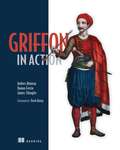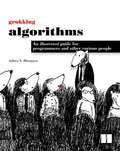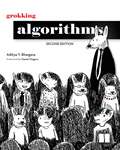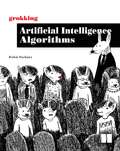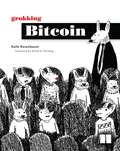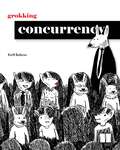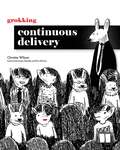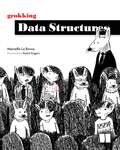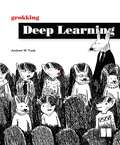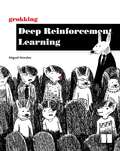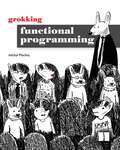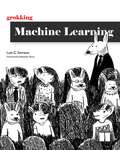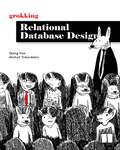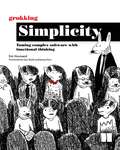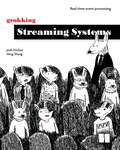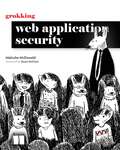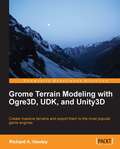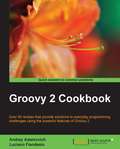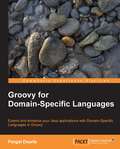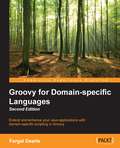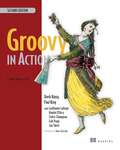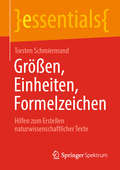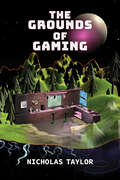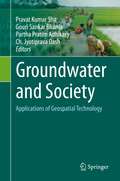- Table View
- List View
Griffon in Action
by Andres Almiray Danno FerrinSummaryGriffon in Action is a comprehensive tutorial written for Java developers who want a more productive approach to UI development. After a quick Groovy tutorial, you'll immediately dive into Griffon and start building examples that explore its high productivity approach to Swing development.About the TechnologyYou can think of Griffon as Grails for the desktop. It is a Groovy-driven UI framework for the JVM that wraps and radically simplifies Swing. Its declarative style and approachable abstractions are instantly familiar to developers using Grails or JavaFX.About the BookGriffon in Action gets you going quickly. Griffon's convention-over-configuration approach requires minimal code to get an app off the ground, so you can start seeing results immediately. You'll learn how SwingBuilder and other Griffon "builders" provide a coherent DSL-driven development experience. Along the way, you'll explore best practices for structure, architecture, and lifecycle of a Java desktop application.Written for Java developers—no experience with Groovy, Grails, or Swing is required. Purchase of the print book comes with an offer of a free PDF, ePub, and Kindle eBook from Manning. Also available is all code from the book. What's InsideGriffon from the ground upFull compatibility with Griffon 1.0Using SwingBuilder and the other "builders"Practical, real-world examplesJust enough Groovy=======================================Table of ContentsPART 1 GETTING STARTEDWelcome to the Griffon revolutionA closer look at GriffonPART 2 ESSENTIAL GRIFFONModels and bindingCreating a viewUnderstanding controllers and servicesUnderstanding MVC groupsMultithreaded applicationsListening to notificationsTesting your applicationShip it!Working with pluginsEnhanced looksGriffon in front, Grails in the backProductivity tools
Grok 1.0 Web Development
by Carlos De GuardiaThe book takes a practical approach and dives into code right from the start. After learning how to install Grok, we create a simple application. We work on this application throughout the book, until its deployment in the last chapter. In each chapter, some new features of Grok will be introduced and explained, then the application will be extended to use them, explaining step-by-step how each feature works. This book is intended for Python developers who want to create web applications but have little or no experience in web development. If you have used other web frameworks but are looking for one that enables you to create more complex applications without losing agility, you will also benefit from this book. The reader is expected to have some basic Python knowledge and at least a general idea of how a web application works.
Grokking Algorithms: An illustrated guide for programmers and other curious people
by Aditya BhargavaSummaryGrokking Algorithms is a fully illustrated, friendly guide that teaches you how to apply common algorithms to the practical problems you face every day as a programmer. You'll start with sorting and searching and, as you build up your skills in thinking algorithmically, you'll tackle more complex concerns such as data compression and artificial intelligence. Each carefully presented example includes helpful diagrams and fully annotated code samples in Python.Learning about algorithms doesn't have to be boring! Get a sneak peek at the fun, illustrated, and friendly examples you'll find in Grokking Algorithms on Manning Publications' YouTube channel.Continue your journey into the world of algorithms with Algorithms in Motion, a practical, hands-on video course available exclusively at Manning.com (www.manning.com/livevideo/algorithms-in-motion).Purchase of the print book includes a free eBook in PDF, Kindle, and ePub formats from Manning Publications.About the TechnologyAn algorithm is nothing more than a step-by-step procedure for solving a problem. The algorithms you'll use most often as a programmer have already been discovered, tested, and proven. If you want to understand them but refuse to slog through dense multipage proofs, this is the book for you. This fully illustrated and engaging guide makes it easy to learn how to use the most important algorithms effectively in your own programs.About the BookGrokking Algorithms is a friendly take on this core computer science topic. In it, you'll learn how to apply common algorithms to the practical programming problems you face every day. You'll start with tasks like sorting and searching. As you build up your skills, you'll tackle more complex problems like data compression and artificial intelligence. Each carefully presented example includes helpful diagrams and fully annotated code samples in Python. By the end of this book, you will have mastered widely applicable algorithms as well as how and when to use them.What's InsideCovers search, sort, and graph algorithmsOver 400 pictures with detailed walkthroughsPerformance trade-offs between algorithmsPython-based code samplesAbout the ReaderThis easy-to-read, picture-heavy introduction is suitable for self-taught programmers, engineers, or anyone who wants to brush up on algorithms.About the AuthorAditya Bhargava is a Software Engineer with a dual background in Computer Science and Fine Arts. He blogs on programming at adit.io.Table of ContentsIntroduction to algorithmsSelection sortRecursionQuicksortHash tablesBreadth-first searchDijkstra's algorithmGreedy algorithmsDynamic programmingK-nearest neighbors
Grokking Algorithms, Second Edition
by Aditya Y BhargavaA friendly, fully-illustrated introduction to the most important computer programming algorithms.Master the most widely used algorithms and be fully prepared when you&’re asked about them at your next job interview. With beautifully simple explanations, over 400 fun illustrations, and dozens of relevant examples, you&’ll actually enjoy learning about algorithms with this fun and friendly guide! In Grokking Algorithms, Second Edition you will discover: Search, sort, and graph algorithms Data structures such as arrays, lists, hash tables, trees, and graphs NP-complete and greedy algorithms Performance trade-offs between algorithms Exercises and code samples in every chapter Over 400 illustrations with detailed walkthroughs The first edition of Grokking Algorithms proved to over 100,000 readers that learning algorithms doesn't have to be complicated or boring! This revised second edition contains brand new coverage of trees, including binary search trees, balanced trees, B-trees and more. You&’ll also discover fresh insights on data structure performance that takes account of modern CPUs. Plus, the book&’s fully annotated code samples have been updated to Python 3. Foreword by Daniel Zingaro. About the technology The algorithms you use most often have already been discovered, tested, and proven. Grokking Algorithms, Second Edition makes it a breeze to learn, understand, and use them. With beautifully simple explanations, over 400 fun illustrations, and dozens of relevant examples, it&’s the perfect way to unlock the power of algorithms in your everyday work and prepare for your next coding interview—no math required! About the book Grokking Algorithms, Second Edition teaches you important algorithms to speed up your programs, simplify your code, and solve common programming problems. Start with tasks like sorting and searching, then build your skills to tackle advanced problems like data compression and artificial intelligence. You&’ll even learn to compare the performance tradeoffs between algorithms. Plus, this new edition includes fresh coverage of trees, NP-complete problems, and code updates to Python 3. What's inside Search, sort, and graph algorithms Data structures such as arrays, lists, hash tables, trees, and graphs NP-complete and greedy algorithms Exercises and code samples in every chapter About the reader No advanced math or programming skills required. About the author Aditya Bhargava is a Software Engineer with a dual background in Computer Science and Fine Arts. He blogs on programming at adit.io. Table of Contents 1 Introduction to algorithms 2 Selection sort 3 Recursion 4 Quicksort 5 Hash tables 6 Beadth-first search 7 Trees 8 Balanced trees 9 Dijkstra&’s algorithm 10 Greedy algorithms 11 Dynamic programming 12 k-nearest neighbors 13 where to go next
Grokking Artificial Intelligence Algorithms
by Rishal Hurbans&”This book takes an impossibly broad area of computer science and communicates what working developers need to understand in a clear and thorough way.&” - David Jacobs, Product Advance Local Key Features Master the core algorithms of deep learning and AI Build an intuitive understanding of AI problems and solutions Written in simple language, with lots of illustrations and hands-on examples Creative coding exercises, including building a maze puzzle game and exploring drone optimizationAbout The Book &“Artificial intelligence&” requires teaching a computer how to approach different types of problems in a systematic way. The core of AI is the algorithms that the system uses to do things like identifying objects in an image, interpreting the meaning of text, or looking for patterns in data to spot fraud and other anomalies. Mastering the core algorithms for search, image recognition, and other common tasks is essential to building good AI applications Grokking Artificial Intelligence Algorithms uses illustrations, exercises, and jargon-free explanations to teach fundamental AI concepts.You&’ll explore coding challenges like detecting bank fraud, creating artistic masterpieces, and setting a self-driving car in motion. All you need is the algebra you remember from high school math class and beginning programming skills. What You Will Learn Use cases for different AI algorithms Intelligent search for decision making Biologically inspired algorithms Machine learning and neural networks Reinforcement learning to build a better robot This Book Is Written For For software developers with high school–level math skills. About the Author Rishal Hurbans is a technologist, startup and AI group founder, and international speaker. Table of Contents 1 Intuition of artificial intelligence 2 Search fundamentals 3 Intelligent search 4 Evolutionary algorithms 5 Advanced evolutionary approaches 6 Swarm intelligence: Ants 7 Swarm intelligence: Particles 8 Machine learning 9 Artificial neural networks 10 Reinforcement learning with Q-learning
Grokking Bitcoin
by Kalle RosenbaumSummaryIf you think Bitcoin is just an alternative currency for geeks, it's time to think again. Grokking Bitcoin opens up this powerful distributed ledger system, exploring the technology that enables applications both for Bitcoin-based financial transactions and using the blockchain for registering physical property ownership. With this fully illustrated, easy-to-read guide, you'll finally understand how Bitcoin works, how you can use it, and why you can trust the blockchain.Foreword by David A. Harding, Contributor to Bitcoin documentation.Purchase of the print book includes a free eBook in PDF, Kindle, and ePub formats from Manning Publications.About the TechnologyInflation, depressed economies, debased currencies ... these are just a few of the problems centralized banking has caused throughout history. Bitcoin, a digital currency created with the ambition to shift control away from change-prone governments, has the potential to bring an end to those problems once and for all. It's time to find out how it can help you.About the BookGrokking Bitcoin explains why Bitcoin's supporters trust it so deeply, and why you can too. This approachable book will introduce you to Bitcoin's groundbreaking technology, which is the key to this world-changing system. This illustrated, easy-to-read guide prepares you for a new way of thinking with easy-to-follow diagrams and exercises. You'll discover how Bitcoin mining works, how to accept Bitcoin, how to participate in the Bitcoin network, and how to set up a digital wallet.What's insideBitcoin transactionsThe blockchainBitcoin miningBitcoin walletsAbout the ReaderIntended for anyone interested in learning about Bitcoin technology. While a basic understanding of technical concepts is beneficial, no programming skills are necessary.About the AuthorKalle Rosenbaum is a computer scientist, an avid Bitcoin supporter, and the founder of Propeller, a Bitcoin consultancy.Table of ContentsIntroduction to BitcoinCryptographic hash functions and digital signaturesAddressesWalletsTransactionsThe blockchainProof of workPeer-to-peer networkTransactions revisitedSegregated witnessBitcoin upgrades
Grokking Concurrency
by Kiril BobrovThis easy-to-read, hands-on guide demystifies concurrency concepts like threading, asynchronous programming, and parallel processing in any language.Perplexed by concurrency? Don&’t be. This engaging, fully-illustrated beginner&’s guide gets you writing the kind of high-performance code your apps deserve. Inside, you&’ll find thorough explanations of concurrency&’s core concepts—all explained with interesting illustrations, insightful examples, and detailed techniques you can apply to your own projects. In Grokking Concurrency you will: Get up to speed with the core concepts of concurrency, asynchrony, and parallel programming Learn the strengths and weaknesses of different hardware architectures Improve the sequential performance characteristics of your software Solve common problems for concurrent programming Compose patterns into a series of practices for writing scalable systems Write and implement concurrency systems that scale to any size Discover effective concurrency practices that will help you leverage multiple cores, excel with high loads, handle terabytes of data, and continue working after hardware and software failures. The core concepts in this guide will remain eternally relevant, whether you&’re building web apps, IoT systems, or handling big data. About the technology Concurrency is an approach to running computer programs efficiently by separating them into tasks that can execute independently. This basic idea makes it possible to accelerate game graphics, train large AI models, rapidly scale web applications, streamline big data processing, and much more. Concurrency can get complicated, so this book gets you started gently with interesting examples, entertaining illustrations, and easy-to-follow Python code. About the book Grokking Concurrency is a perfectly paced introduction to the fundamentals of concurrent, parallel, and asynchronous programming. In it, you&’ll learn the practices you&’ll need to program multicore processors, GPUs, and other high-performance systems. Author Kirill Bobrov skips the math, jargon, and academic language and concentrates on clear, plain-English explanations. What's inside Writing and running concurrent programs Patterns for performance, scalability, and resilience Choosing the right hardware Asynchronous communication About the reader Examples in Python. No prior experience with concurrency or high-performance computing required. About the author Kirill Bobrov is a software engineer with a passion for data engineering. Table of Contents Part 1 The Octopus Orchestra: Introduction to a Symphony of Concurrency 1 Introducing concurrency 2 Serial and parallel execution 3 How computers work 4 Building blocks of concurrency 5 Interprocess communication Part 2 the Many Tentacles of Concurrency: Multitasking, Decomposition, and Synchronization 6 Multitasking 7 Decomposition 8 Solving concurrency problems: Race conditions and synchronization 9 Solving concurrency problems: Deadlocks and starvation Part 3 Asynchronous Octopuses: a Pizza-making Tale of Concurrency 10 Nonblocking I/O 11 Event-based concurrency 12 Asynchronous communication 13 Writing concurrent applications
Grokking Continuous Delivery
by Christie WilsonBuild and use systems that safely automate software delivery from testing through release with this jargon-busting guide to continuous delivery pipelines.In Grokking Continuous Delivery you will learn how to: Design effective CD pipelines for new and legacy projects Keep your software projects release-ready Maintain effective tests Scale CD across multiple applications Ensure pipelines give the right signals at the right time Use version control as the source of truth Safely automate deployments with metrics Describe CD in a way that makes sense to your colleagues Grokking Continuous Delivery teaches you the design and purpose of continuous delivery systems that you can use with any language or stack. You&’ll learn directly from your mentor Christie Wilson, Google engineer and co-creator of the Tekton CI/CD framework. Using crystal-clear, well-illustrated examples, Christie lays out the practical nuts and bolts of continuous delivery for developers and pipeline designers. In each chapter, you&’ll uncover the proper approaches to solve the real-world challenges of setting up a CD pipeline. With this book as your roadmap, you&’ll have a clear plan for bringing CD to your team without the need for costly trial-and-error experimentation. About the technology Keep your codebase release-ready. A continuous delivery pipeline automates version control, testing, and deployment with minimal developer intervention. Master the tools and practices of continuous delivery, and you&’ll be able to add features and push updates quickly and consistently. About the book Grokking Continuous Delivery is a friendly guide to setting up and working with a continuous delivery pipeline. Each chapter takes on a different scenario you&’ll face when setting up a CD system, with real-world examples like automated scaling and testing legacy applications. Taking a tool-agnostic approach, author Christie Wilson guides you each step of the way with illustrations, crystal-clear explanations, and practical exercises to lock in what you&’re learning. What's inside Design effective CD pipelines for new and legacy projects Ensure your pipelines give the right signals at the right times Version control as the source of truth Safely automate deployments About the reader For software engineers who want to add CD to their development process. About the author Christie Wilson is a software engineer at Google, where she co-created Tekton, a cloud-native CI/CD platform built on Kubernetes. Table of Contents PART 1 Introducing continuous delivery 1 Welcome to Grokking Continuous Delivery 2 A basic pipeline PART 2 Keeping software in a deliverable state at all times 3 Version control is the only way to roll 4 Use linting effectively 5 Dealing with noisy tests 6 Speeding up slow test suites 7 Give the right signals at the right times PART 3 Making delivery easy 8 Easy delivery starts with version control 9 Building securely and reliably 10 Deploying confidently PART 4 CD design 11 Starter packs: From zero to CD 12 Scripts are code, too 13 Pipeline design
Grokking Data Structures
by Marcello La RoccaDon&’t be perplexed by data structures! This fun, friendly, and fully illustrated guide makes it easy to learn useful data structures you&’ll put to work every day.Grokking Data Structures makes it a breeze to learn the most useful day-to-day data structures. You&’ll follow a steady learning path from absolute basics to advanced concepts, all illustrated with fun examples, engaging industry stories, and hundreds of graphics and cartoons. In Grokking Data Structures you&’ll learn how to: • Understand the most important and widely used data structures • Identify use cases where data structures make the biggest difference • Pick the best data structure solution for a coding challenge • Understand the tradeoffs of data structures and avoid catastrophes • Implement basic data collections like arrays, linked lists, stacks, and priority queues • Use trees and binary search trees (BSTs) to organize data • Use graphs to model relationships and learn about complex data • Efficiently search by key using hash tables and hashing functions • Reason about time and memory requirements of operations on data structures Grokking Data Structures carefully guides you from the most basic data structures like arrays or linked lists all the way to powerful structures like graphs. It&’s perfect for beginners, and you won&’t need anything more than high school math to get started. Each data structure you encounter comes with its own complete Python implementation so you can start experimenting with what you learn right away. Foreword by Daniel Zingaro. About the technology Data structures are vital for shaping and handling your data organization. They&’re also an important part of most IT job interviews! Whether you&’re new to data structures or just dusting off what you learned in school, this book will get you up to speed fast with no advanced math, abstract theory, or complicated proofs. About the book Grokking Data Structures introduces common and useful data structures that every developer needs to know. Real-world examples show you how data structures are used in practice, from making your searches faster to handling triage in an emergency room. You&’ll love the fun cartoons, insightful stories, and useful Python code samples that make data structures come alive. And unlike jargon-laden academic texts, this book is easy-to-read and practical. What's inside • Fast searches using hash tables • Trees and binary search trees (BSTs) to organize data • Use graphs to model complex data • The best data structures for a coding challenge About the reader For readers who know the basics of Python. A perfect companion to Grokking Algorithms! About the author Marcello La Rocca is a research scientist and a full-stack engineer. He has contributed to large-scale web applications and machine learning infrastructure at Twitter, Microsoft, and Apple. The technical editor on this book was Beau Carnes. Table of Contents 1 Introducing data structures: Why you should learn about data structures 2 Static arrays: Building your first data structure 3 Sorted arrays: Searching faster, at a price 4 Big-O notation: A framework for measuring algorithm efficiency 5 Dynamic arrays: Handling dynamically sized datasets 6 Linked lists: A flexible dynamic collection 7 Abstract data types: Designing the simplest container—the bag 8 Stacks: Piling up data before processing it 9 Queues: Keeping information in the same order as it arrives 10 Priority queues and heaps: Handling data according to its priority 11 Binary search trees: A balanced container 12 Dictionaries and hash tables: How to build and use associative arrays 13 Gr
Grokking Deep Learning
by Andrew W. TraskSummaryGrokking Deep Learning teaches you to build deep learning neural networks from scratch! In his engaging style, seasoned deep learning expert Andrew Trask shows you the science under the hood, so you grok for yourself every detail of training neural networks.Purchase of the print book includes a free eBook in PDF, Kindle, and ePub formats from Manning Publications.About the TechnologyDeep learning, a branch of artificial intelligence, teaches computers to learn by using neural networks, technology inspired by the human brain. Online text translation, self-driving cars, personalized product recommendations, and virtual voice assistants are just a few of the exciting modern advancements possible thanks to deep learning.About the BookGrokking Deep Learning teaches you to build deep learning neural networks from scratch! In his engaging style, seasoned deep learning expert Andrew Trask shows you the science under the hood, so you grok for yourself every detail of training neural networks. Using only Python and its math-supporting library, NumPy, you'll train your own neural networks to see and understand images, translate text into different languages, and even write like Shakespeare! When you're done, you'll be fully prepared to move on to mastering deep learning frameworks.What's insideThe science behind deep learningBuilding and training your own neural networksPrivacy concepts, including federated learningTips for continuing your pursuit of deep learningAbout the ReaderFor readers with high school-level math and intermediate programming skills.About the AuthorAndrew Trask is a PhD student at Oxford University and a research scientist at DeepMind. Previously, Andrew was a researcher and analytics product manager at Digital Reasoning, where he trained the world's largest artificial neural network and helped guide the analytics roadmap for the Synthesys cognitive computing platform.Table of ContentsIntroducing deep learning: why you should learn itFundamental concepts: how do machines learn?Introduction to neural prediction: forward propagationIntroduction to neural learning: gradient descentLearning multiple weights at a time: generalizing gradient descentBuilding your first deep neural network: introduction to backpropagationHow to picture neural networks: in your head and on paperLearning signal and ignoring noise:introduction to regularization and batchingModeling probabilities and nonlinearities: activation functionsNeural learning about edges and corners: intro to convolutional neural networksNeural networks that understand language: king - man + woman == ?Neural networks that write like Shakespeare: recurrent layers for variable-length dataIntroducing automatic optimization: let's build a deep learning frameworkLearning to write like Shakespeare: long short-term memoryDeep learning on unseen data: introducing federated learningWhere to go from here: a brief guide
Grokking Deep Reinforcement Learning
by Miguel MoralesGrokking Deep Reinforcement Learning uses engaging exercises to teach you how to build deep learning systems. This book combines annotated Python code with intuitive explanations to explore DRL techniques. You&’ll see how algorithms function and learn to develop your own DRL agents using evaluative feedback.Summary We all learn through trial and error. We avoid the things that cause us to experience pain and failure. We embrace and build on the things that give us reward and success. This common pattern is the foundation of deep reinforcement learning: building machine learning systems that explore and learn based on the responses of the environment. Grokking Deep Reinforcement Learning introduces this powerful machine learning approach, using examples, illustrations, exercises, and crystal-clear teaching. You'll love the perfectly paced teaching and the clever, engaging writing style as you dig into this awesome exploration of reinforcement learning fundamentals, effective deep learning techniques, and practical applications in this emerging field. Purchase of the print book includes a free eBook in PDF, Kindle, and ePub formats from Manning Publications. About the technology We learn by interacting with our environment, and the rewards or punishments we experience guide our future behavior. Deep reinforcement learning brings that same natural process to artificial intelligence, analyzing results to uncover the most efficient ways forward. DRL agents can improve marketing campaigns, predict stock performance, and beat grand masters in Go and chess. About the book Grokking Deep Reinforcement Learning uses engaging exercises to teach you how to build deep learning systems. This book combines annotated Python code with intuitive explanations to explore DRL techniques. You&’ll see how algorithms function and learn to develop your own DRL agents using evaluative feedback. What's inside An introduction to reinforcement learning DRL agents with human-like behaviors Applying DRL to complex situations About the reader For developers with basic deep learning experience. About the author Miguel Morales works on reinforcement learning at Lockheed Martin and is an instructor for the Georgia Institute of Technology&’s Reinforcement Learning and Decision Making course. Table of Contents 1 Introduction to deep reinforcement learning 2 Mathematical foundations of reinforcement learning 3 Balancing immediate and long-term goals 4 Balancing the gathering and use of information 5 Evaluating agents&’ behaviors 6 Improving agents&’ behaviors 7 Achieving goals more effectively and efficiently 8 Introduction to value-based deep reinforcement learning 9 More stable value-based methods 10 Sample-efficient value-based methods 11 Policy-gradient and actor-critic methods 12 Advanced actor-critic methods 13 Toward artificial general intelligence
Grokking Functional Programming
by Michal PlachtaThere&’s no need to fear going functional! This friendly, lively, and engaging guide is perfect for any perplexed programmer. It lays out the principles of functional programming in a simple and concise way that will help you grok what FP is really all about.In Grokking Functional Programming you will learn: Designing with functions and types instead of objects Programming with pure functions and immutable values Writing concurrent programs using the functional style Testing functional programs Multiple learning approaches to help you grok each new concept If you&’ve ever found yourself rolling your eyes at functional programming, this is the book for you. Open up Grokking Functional Programming and you&’ll find functional ideas mapped onto what you already know as an object-oriented programmer. The book focuses on practical aspects from page one. Hands-on examples apply functional principles to everyday programming tasks like concurrency, error handling, and improving readability. Plus, puzzles and exercises let you think and practice what you're learning. You&’ll soon reach an amazing &“aha&” moment and start seeing code in a completely new way. About the technology Finally, there&’s an easy way to learn functional programming! This unique book starts with the familiar ideas of OOP and introduces FP step-by-step using relevant examples, engaging exercises, and lots of illustrations. You&’ll be amazed at how quickly you&’ll start seeing software tasks from this valuable new perspective. About the book Grokking Functional Programming introduces functional programming to imperative developers. You&’ll start with small, comfortable coding tasks that expose basic concepts like writing pure functions and working with immutable data. Along the way, you&’ll learn how to write code that eliminates common bugs caused by complex distributed state. You&’ll also explore the FP approach to IO, concurrency, and data streaming. By the time you finish, you&’ll be writing clean functional code that&’s easy to understand, test, and maintain. What's inside Designing with functions and types instead of objects Programming with pure functions and immutable values Writing concurrent programs using the functional style Testing functional programs About the reader For developers who know an object-oriented language. Examples in Java and Scala. About the author Michal Plachta is an experienced software developer who regularly speaks and writes about creating maintainable applications. Table of Contents Part 1 The functional toolkit 1 Learning functional programming 2 Pure functions 3 Immutable values 4 Functions as values Part 2 Functional programs 5 Sequential programs 6 Error handling 7 Requirements as types 8 IO as values 9 Streams as values 10 Concurrent programs Part 3 Applied functional programming 11 Designing functional programs 12 Testing functional programs
Grokking Machine Learning
by Luis SerranoDiscover valuable machine learning techniques you can understand and apply using just high-school math.In Grokking Machine Learning you will learn: Supervised algorithms for classifying and splitting data Methods for cleaning and simplifying data Machine learning packages and tools Neural networks and ensemble methods for complex datasets Grokking Machine Learning teaches you how to apply ML to your projects using only standard Python code and high school-level math. No specialist knowledge is required to tackle the hands-on exercises using Python and readily available machine learning tools. Packed with easy-to-follow Python-based exercises and mini-projects, this book sets you on the path to becoming a machine learning expert. Purchase of the print book includes a free eBook in PDF, Kindle, and ePub formats from Manning Publications. About the technology Discover powerful machine learning techniques you can understand and apply using only high school math! Put simply, machine learning is a set of techniques for data analysis based on algorithms that deliver better results as you give them more data. ML powers many cutting-edge technologies, such as recommendation systems, facial recognition software, smart speakers, and even self-driving cars. This unique book introduces the core concepts of machine learning, using relatable examples, engaging exercises, and crisp illustrations. About the book Grokking Machine Learning presents machine learning algorithms and techniques in a way that anyone can understand. This book skips the confused academic jargon and offers clear explanations that require only basic algebra. As you go, you&’ll build interesting projects with Python, including models for spam detection and image recognition. You&’ll also pick up practical skills for cleaning and preparing data. What's inside Supervised algorithms for classifying and splitting data Methods for cleaning and simplifying data Machine learning packages and tools Neural networks and ensemble methods for complex datasets About the reader For readers who know basic Python. No machine learning knowledge necessary. About the author Luis G. Serrano is a research scientist in quantum artificial intelligence. Previously, he was a Machine Learning Engineer at Google and Lead Artificial Intelligence Educator at Apple. Table of Contents 1 What is machine learning? It is common sense, except done by a computer 2 Types of machine learning 3 Drawing a line close to our points: Linear regression 4 Optimizing the training process: Underfitting, overfitting, testing, and regularization 5 Using lines to split our points: The perceptron algorithm 6 A continuous approach to splitting points: Logistic classifiers 7 How do you measure classification models? Accuracy and its friends 8 Using probability to its maximum: The naive Bayes model 9 Splitting data by asking questions: Decision trees 10 Combining building blocks to gain more power: Neural networks 11 Finding boundaries with style: Support vector machines and the kernel method 12 Combining models to maximize results: Ensemble learning 13 Putting it all in practice: A real-life example of data engineering and machine learning
Grokking Relational Database Design
by Qiang Hao Michail TsikerdekisA friendly illustrated guide to designing and implementing your first database.Grokking Relational Database Design makes the principles of designing relational databases approachable and engaging. Everything in this book is reinforced by hands-on exercises and examples. In Grokking Relational Database Design, you&’ll learn how to: • Query and create databases using Structured Query Language (SQL) • Design databases from scratch • Implement and optimize database designs • Take advantage of generative AI when designing databases A well-constructed database is easy to understand, query, manage, and scale when your app needs to grow. In Grokking Relational Database Design you&’ll learn the basics of relational database design including how to name fields and tables, which data to store where, how to eliminate repetition, good practices for data collection and hygiene, and much more. You won&’t need a computer science degree or in-depth knowledge of programming—the book&’s practical examples and down-to-earth definitions are beginner-friendly. About the technology Almost every business uses a relational database system. Whether you&’re a software developer, an analyst creating reports and dashboards, or a business user just trying to pull the latest numbers, it pays to understand how a relational database operates. This friendly, easy-to-follow book guides you from square one through the basics of relational database design. About the book Grokking Relational Database Design introduces the core skills you need to assemble and query tables using SQL. The clear explanations, intuitive illustrations, and hands-on projects make database theory come to life, even if you can&’t tell a primary key from an inner join. As you go, you&’ll design, implement, and optimize a database for an e-commerce application and explore how generative AI simplifies the mundane tasks of database designs. What's inside • Define entities and their relationships • Minimize anomalies and redundancy • Use SQL to implement your designs • Security, scalability, and performance About the reader For self-taught programmers, software engineers, data scientists, and business data users. No previous experience with relational databases assumed. About the author Dr. Qiang Hao and Dr. Michail Tsikerdekis are both professors of Computer Science at Western Washington University. Table of Contents Part 1 1 Introducing databases and SQL 2 Related tables and more SQL 3 Overview of database design Part 2 4 Entities and attributes 5 Relationships 6 Normalization and implementation 7 Security and optimization Part 3 8 Database design in the age of generative AI
Grokking Simplicity: Taming complex software with functional thinking
by Eric NormandGrokking Simplicity is a friendly, practical guide that will change the way you approach software design and development.Summary Distributed across servers, difficult to test, and resistant to modification—modern software is complex. Grokking Simplicity is a friendly, practical guide that will change the way you approach software design and development. It introduces a unique approach to functional programming that explains why certain features of software are prone to complexity, and teaches you the functional techniques you can use to simplify these systems so that they&’re easier to test and debug. Purchase of the print book includes a free eBook in PDF, Kindle, and ePub formats from Manning Publications. About the technology Developers rightly fear the unintended complexity that infects most code. This book shows you how to write software that keeps complexity close to its inherent minimum. As you write software you should distinguish between code that alters your system&’s state, and code that does not. Once you learn to make that distinction, you can refactor much of your state-altering &“actions&” into stateless &“calculations.&” Your software will be simpler. About the book The book also teaches you to solve the complex timing bugs that inevitably creep into asynchronous and multithreaded code. In advanced sections of the book you learn how composable abstractions help avoid repeating code and open up new levels of expressivity. What's inside Patterns for simpler code Powerful time modeling approaches to simplify asynchronous code How higher-order functions can make code reusable and composable About the reader For intermediate and advanced developers building complex software. Exercises, illustrations, self-assessments, and hands-on examples lock in each new idea. About the author Eric Normand is an expert software developer who has been an influential teacher of functional programming since 2007. Table of Contents 1 Welcome to Grokking Simplicity 2 Functional thinking in action PART 1 - ACTIONS, CALCULATIONS, AND DATA 3 Distinguishing actions, calculations, and data 4 Extracting calculations from actions 5 Improving the design of actions 6 Staying immutable in a mutable language 7 Staying immutable with untrusted code 8 Stratified design, part 1 9 Stratified design, part 2 PART 2 - FIRST-CLASS ABSTRACTIONS 10 First-class functions, part 1 11 First-class functions, part 2 12 Functional iteration 13 Chaining functional tools 14 Functional tools for nested data 15 Isolating timelines 16 Sharing resources between timelines 17 Coordinating timelines 18 Reactive and onion architectures 19 The functional journey ahead
Grokking Streaming Systems: Real-time event processing
by Josh Fischer Ning WangA friendly, framework-agnostic tutorial that will help you grok how streaming systems work—and how to build your own!In Grokking Streaming Systems you will learn how to: Implement and troubleshoot streaming systems Design streaming systems for complex functionalities Assess parallelization requirements Spot networking bottlenecks and resolve back pressure Group data for high-performance systems Handle delayed events in real-time systems Grokking Streaming Systems is a simple guide to the complex concepts behind streaming systems. This friendly and framework-agnostic tutorial teaches you how to handle real-time events, and even design and build your own streaming job that&’s a perfect fit for your needs. Each new idea is carefully explained with diagrams, clear examples, and fun dialogue between perplexed personalities! About the technology Streaming systems minimize the time between receiving and processing event data, so they can deliver responses in real time. For applications in finance, security, and IoT where milliseconds matter, streaming systems are a requirement. And streaming is hot! Skills on platforms like Spark, Heron, and Kafka are in high demand. About the book Grokking Streaming Systems introduces real-time event streaming applications in clear, reader-friendly language. This engaging book illuminates core concepts like data parallelization, event windows, and backpressure without getting bogged down in framework-specific details. As you go, you&’ll build your own simple streaming tool from the ground up to make sure all the ideas and techniques stick. The helpful and entertaining illustrations make streaming systems come alive as you tackle relevant examples like real-time credit card fraud detection and monitoring IoT services. What's inside Implement and troubleshoot streaming systems Design streaming systems for complex functionalities Spot networking bottlenecks and resolve backpressure Group data for high-performance systems About the reader No prior experience with streaming systems is assumed. Examples in Java. About the author Josh Fischer and Ning Wang are Apache Committers, and part of the committee for the Apache Heron distributed stream processing engine. Table of Contents PART 1 GETTING STARTED WITH STREAMING 1 Welcome to Grokking Streaming Systems 2 Hello, streaming systems! 3 Parallelization and data grouping 4 Stream graph 5 Delivery semantics 6 Streaming systems review and a glimpse ahead PART 2 STEPPING UP 7 Windowed computations 8 Join operations 9 Backpressure 10 Stateful computation 11 Wrap-up: Advanced concepts in streaming systems
Grokking Web Application Security
by Malcolm McDonaldWhen you launch an application on the web, every hacker in the world has access to it. Are you sure your web apps can stand up to the most sophisticated attacks?Trying to teach yourself about web security from the internet can feel like walking into a huge disorganized library—one where you can never find what you need, and the wrong advice might endanger your application! You need a single, all-in-one guide to securing your apps against all the attacks they can and will face. You need Grokking Web Application Security. This brilliantly illustrated and clearly written guide delivers detailed coverage on: Browser security, including sandboxing, the same-origin policy, and cookie security Securing web servers with input validation, escaping of output, and defense in depth A development process that prevents security bugs Browser vulnerabilities, from cross-site scripting and cross-site request forgery, to clickjacking Network vulnerabilities, such as man-in-the-middle attacks, SSL-stripping, and DNS poisoning Authentication vulnerabilities, such as brute forcing of credentials with single sign-on or multi-factor authentication Authorization vulnerabilities, such as broken access control and session jacking How to use encryption in web applications Injection attacks, command execution attacks, and remote code execution attacks Malicious payloads that can be used to attack XML parsers and file upload functions Grokking Web Application Security teaches you how to build web apps that are ready and resilient to any attack. It&’s laser-focused on what the working programmer needs to know about web security. In it, you&’ll find practical recommendations for both common and not-so-common vulnerabilities—everything from SQL injection to cross-site scripting inclusion attacks. You&’ll learn what motivates hackers, discover the latest tools for identifying issues, and set up a development lifecycle that catches problems early. Read it cover to cover for a comprehensive overview of web security, and dip in as a reference whenever you need to tackle a specific vulnerability. About the technology Application security is a front-burner concern for web developers. Whether working on the UI with a frontend framework or building out the server side, it&’s up to you to understand the threats and know exactly how to keep the black hats from getting the upper hand. About the book Grokking Web Application Security covers everything a working developer needs to know about securing applications in the browser and on the server. The tested techniques apply to any stack and are illustrated with concrete examples plucked from author Malcolm McDonald&’s extensive career. You&’ll discover must-implement security principles and even learn the fascinating tools and techniques the bad guys use to crack systems. What's inside A security-first development process Encryption in web applications Supply-chain and API attacks What to do when a hacker gets in About the reader For readers who understand basic web application design and technologies. About the author Malcolm McDonald is a security engineer with 20 years of experience across investment banking, start-ups, and PayPal, and he is the creator of hacksplaining.com. The technical editor on this book was Rajvardhan Oak.
Grome Terrain Modeling with Ogre3D, UDK, and Unity3D
by Richard HawleyThis book is a practical guide with examples and clear steps to explain terrain modeling with Grome.If you're a developer or artist looking for a guide to walk you through GROME 3.1, then this book is for you. This book will help you from the first step to exporting a terrain as a workable art asset in a game engine
Groovy 2 Cookbook
by Luciano Fiandesio Andrey AdamovichThis book follows a Cookbook style and is packed with intermediate and advanced level recipes.This book is for Java developers who have an interest in discovering new ways to quickly get the job done using a new language that shares many similarities with Java. The book's recipes start simple, therefore no previous Groovy experience is required to understand the code and the explanations accompanying the examples.
Groovy for Domain-Specific Languages
by Fergal DearleThis book is a practical tutorial, walking the reader through examples of building DSLs with Groovy covering meta-programming with Groovy. Some complex concepts are covered in the book but we go through these in a clear and methodically way so that readers will gain a good working knowledge of the techniques involved. This book is for Java software developers who have an interest in building domain scripting into their Java applications. No knowledge of Groovy is required, although it will be helpful. The book does not teach Groovy, but quickly introduces the basic ideas of Groovy. An experienced Java developer should have no problems with these and move quickly on to the more involved aspects of creating DSLs with Groovy. No experience of creating a DSL is required. The book should also be useful for experienced Groovy developers who have so far only used Groovy DSLs such as Groovy builders and would like to start building their own Groovy-based DSLs.
Groovy for Domain-specific Languages - Second Edition
by Fergal DearleExtend and enhance your Java applications with domain-specific scripting in Groovy About This Book * Build domain-specific mini languages in Groovy that integrate seamlessly with your Java apps with this hands-on guide * Increase stakeholder participation in the development process with domain-specific scripting in Groovy * Get up to speed with the newest features in Groovy using this second edition and integrate Groovy-based DSLs into your existing Java applications. Who This Book Is For This book is for Java software developers who have an interest in building domain scripting into their Java applications. No knowledge of Groovy is required, although it will be helpful. This book does not teach Groovy, but quickly introduces the basic ideas of Groovy. An experienced Java developer should have no problems with these and move quickly on to the more involved aspects of creating DSLs with Groovy. No experience of creating a DSL is required. What You Will Learn * Familiarize yourself with Groovy scripting and work with Groovy closures * Use the meta-programming features in Groovy to build mini languages * Employ Groovy mark-up and builders to simplify application development * Familiarize yourself with Groovy mark-up and build your own Groovy builders * Build effective DSLs with operator overloading, command chains, builders, and a host of other Groovy language features * Integrate Groovy with your Java and JVM based applications In Detail The times when developing on the JVM meant you were a Java programmer have long passed. The JVM is now firmly established as a polyglot development environment with many projects opting for alternative development languages to Java such as Groovy, Scala, Clojure, and JRuby. In this pantheon of development languages, Groovy stands out for its excellent DSL enabling features which allows it to be manipulated to produce mini languages that are tailored to a project's needs. A comprehensive tutorial on designing and developing mini Groovy based Domain Specific Languages, this book will guide you through the development of several mini DSLs that will help you gain all the skills needed to develop your own Groovy based DSLs with confidence and ease. Starting with the bare basics, this book will focus on how Groovy can be used to construct domain specific mini languages, and will go through the more complex meta-programming features of Groovy, including using the Abstract Syntax Tree (AST). Practical examples are used throughout this book to de-mystify these seemingly complex language features and to show how they can be used to create simple and elegant DSLs. Packed with examples, including several fully worked DSLs, this book will serve as a springboard for developing your own DSLs. Style and approach This book is a hands-on guide that will walk you through examples for building DSLs with Groovy rather than just talking about "metaprogramming with Groovy". The examples in this book have been designed to help you gain a good working knowledge of the techniques involved and apply these to producing your own Groovy based DSLs.
Groovy in Action
by Paul King Cédric Champeau Dierk Koenig Hamlet D'ArcySummaryGroovy in Action, Second Edition is a thoroughly revised, comprehensive guide to Groovy programming. It introduces Java developers to the dynamic features that Groovy provides, and shows how to apply Groovy to a range of tasks including building new apps, integration with existing code, and DSL development. Covers Groovy 2.4.Purchase of the print book includes a free eBook in PDF, Kindle, and ePub formats from Manning Publications.About the TechnologyIn the last ten years, Groovy has become an integral part of a Java developer's toolbox. Its comfortable, common-sense design, seamless integration with Java, and rich ecosystem that includes the Grails web framework, the Gradle build system, and Spock testing platform have created a large Groovy communityAbout the BookGroovy in Action, Second Edition is the undisputed definitive reference on the Groovy language. Written by core members of the Groovy language team, this book presents Groovy like no other can—from the inside out. With relevant examples, careful explanations of Groovy's key concepts and features, and insightful coverage of how to use Groovy in-production tasks, including building new applications, integration with existing code, and DSL development, this is the only book you'll need. Updated for Groovy 2.4.Some experience with Java or another programming language is helpful. No Groovy experience is assumed.What's InsideComprehensive coverage of Groovy 2.4 including language features, libraries, and AST transformationsDynamic, static, and extensible typingConcurrency: actors, data parallelism, and dataflowApplying Groovy: Java integration, XML, SQL, testing, and domain-specific language supportHundreds of reusable examplesAbout the AuthorsAuthors Dierk König, Paul King, Guillaume Laforge, Hamlet D'Arcy, Cédric Champeau, Erik Pragt, and Jon Skeet are intimately involved in the creation and ongoing development of the Groovy language and its ecosystem.Table of ContentsPART 1 THE GROOVY LANGUAGEYour way to GroovyOverture: Groovy basicsSimple Groovy datatypesCollective Groovy datatypesWorking with closuresGroovy control structuresObject orientation, Groovy styleDynamic programming with GroovyCompile-time metaprogramming and AST transformationsGroovy as a static languagePART 2 AROUND THE GROOVY LIBRARYWorking with buildersWorking with the GDKDatabase programming with GroovyWorking with XML and JSONInteracting with Web ServicesIntegrating GroovyPART 3 APPLIED GROOVYUnit testing with GroovyConcurrent Groovy with GParsDomain-specific languagesThe Groovy ecosystem
Größen, Einheiten, Formelzeichen: Hilfen zum Erstellen naturwissenschaftlicher Texte (essentials)
by Torsten SchmiermundSie müssen einen naturwissenschaftlich-technischen Aufsatz schreiben und stehen nun vor dem Problem, ihre wenigen Formeln und Gleichungen korrekt darstellen zu wollen? Sie besitzen bereits Bücher zum Thema „Schreiben einer wissenschaftlichen Arbeit“, möchten zusätzlich aber erfahren, wie Sie bestimmte Sonderzeichen erzeugen können? Sie kennen sich in der Materie schon ganz gut aus, möchten aber regelkonform schreiben? Dieses essential liefert Ihnen Antworten in komprimierter Form. Neben allgemeinen Tipps erhalten Sie auch solche für das Arbeiten mit MS Word und darüber hinaus Informationen zum Umgang mit MS Excel, MS Powerpoint, OpenOffice und LibreOffice.
The Grounds of Gaming (Digital Game Studies)
by Nicholas TaylorHow do we make space for video games in the places where we live, work, and play—and who is allowed to feel welcome there? Despite attempts to expand games beyond their conventional audience of young men, the physical contexts of gameplay and production remain off-limits and unsafe for so many.The Grounds of Gaming explores the physical places where games are played and how they contribute to the persistence of gaming's problematic politics. Drawing on fieldwork in an array of sites, author Nicholas Taylor explores the real-world settings where games are played, watched, discussed and designed. Sometimes these places are sticky, dark, and stinky; other times they are pristine and well appointed. Situating its chapters in such scenes as domestic gaming setups, campus computer labs, LAN parties, esports arenas, and convention centers, Taylor maps the infrastructural connections between games, place, masculinity, and whiteness.By inviting us to reconsider gaming's cultural politics from the ground up, The Grounds of Gaming offers new theoretical insights and practical resources regarding how to make game cultures and industries more inclusive.
Groundwater and Society: Applications of Geospatial Technology
by Gouri Sankar Bhunia Pravat Kumar Shit Partha Pratim Adhikary Ch. Jyotiprava DashThis volume advances the scientific understanding, development, and application of geospatial technologies related to groundwater resource management, mapping, monitoring, and modelling using up-to-date remote sensing and GIS techniques. The book further provides a critical analysis of the debates and discourses surrounding groundwater resources and society, illustrates the relationship between groundwater resources and precision agriculture for societal development, and describes novel, region-specific management strategies and techniques for sustainability with case studies. The book is organized into three parts: (I) Groundwater resources and societal development; (II) Groundwater availability, quality and pollution; and (III) Sustainable groundwater resources management. Each section begins with a short introduction that includes an overview of the papers in that section. Individual chapters focus on the core themes of research and knowledge along with some topics that have received lesser attention. The book will be of interest to water resource planners and decision-makers, academic researchers, policy makers, NGOs, and academic researchers and students in Geography, Geophysics, Hydrology, Remote Sensing & GIS, Agriculture, Soil Science, and Agronomy.
